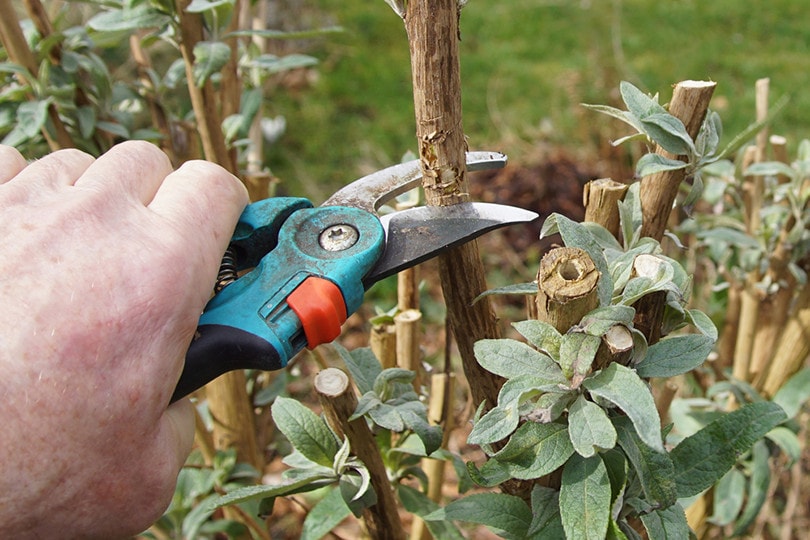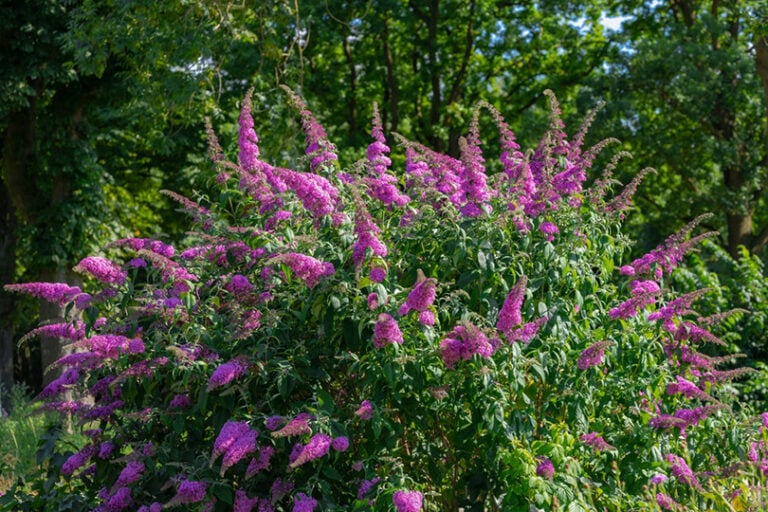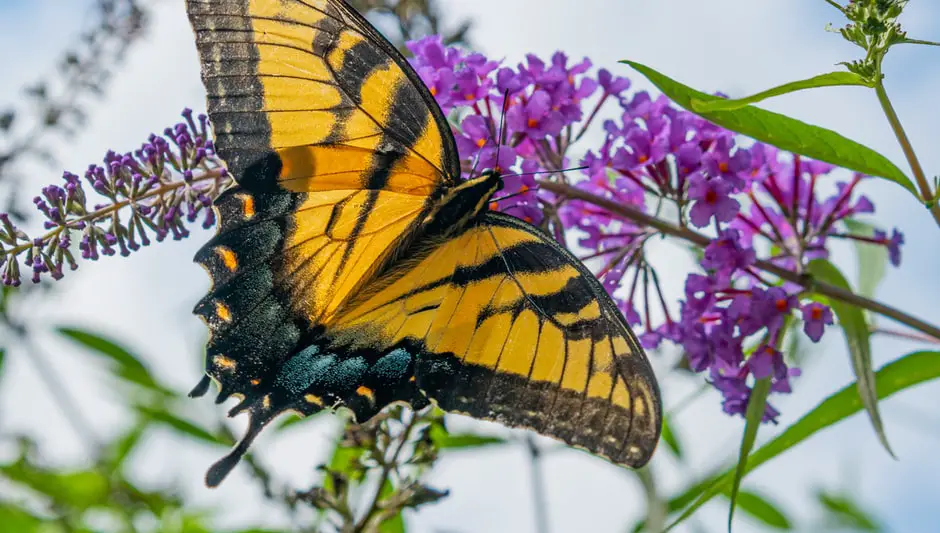Why Prune Your Butterfly Bush in the Fall?
Pruning butterfly bush in the fall is an essential part of its annual care. By pruning at this time, you can promote healthy growth, encourage new blooms, and prepare the plant for winter. Fall pruning also helps prevent disease and pest issues that can arise during the dormant season. When done correctly, pruning can help maintain the plant’s shape, size, and overall appearance, making it a crucial step in its care.
Butterfly bush, also known as Buddleja, is a deciduous shrub that thrives in temperate climates. It produces long, conical flowers that attract butterflies and other pollinators, making it a popular choice for gardens and landscapes. However, if not pruned regularly, the plant can become leggy and overgrown, reducing its flowering potential and overall aesthetic appeal.
Pruning in the fall allows you to remove dead, diseased, or damaged branches, which can help prevent the spread of disease and encourage healthy growth. It also enables you to shape the plant to maintain its desired size and shape, making it a more manageable and attractive addition to your garden.
In addition to promoting healthy growth and preventing disease, fall pruning can also help prepare the plant for winter. By removing dead or damaged branches, you can help protect the plant from harsh winter weather and reduce the risk of damage or dieback.
Overall, pruning butterfly bush in the fall is a simple yet effective way to promote healthy growth, encourage new blooms, and prepare the plant for winter. By incorporating this step into your annual care routine, you can help keep your butterfly bush thriving and enjoy its beautiful flowers for years to come.
How to Prune Your Butterfly Bush for Optimal Results
Pruning butterfly bush in the fall requires the right tools, techniques, and timing. To achieve optimal results, it’s essential to prune your butterfly bush correctly. Here’s a step-by-step guide to help you prune your butterfly bush like a pro:
**Gather the Right Tools**: Before you start pruning, make sure you have the right tools for the job. You’ll need a pair of sharp, clean pruning shears or loppers, depending on the size of your butterfly bush. It’s also a good idea to wear gloves to protect your hands from thorns and sap.
**Choose the Best Time to Prune**: The best time to prune butterfly bush in the fall is after the plant has finished blooming and the flowers have faded. This is usually around late September or early October, depending on your location and climate.
**Make Clean Cuts**: When pruning, make clean cuts just above a growth node (where a leaf meets the stem). Cut at a 45-degree angle, and make sure the cut is smooth and even. This will help the plant heal quickly and reduce the risk of disease.
**Remove Dead, Diseased, or Damaged Branches**: Start by removing any dead, diseased, or damaged branches. Cut these branches off at the base, making sure to disinfect your pruning shears between cuts to prevent the spread of disease.
**Cut Back New Growth**: Once you’ve removed any dead or damaged branches, cut back any new growth to about one-third to one-half of the stem. This will help control the plant’s size and encourage new growth in the spring.
**Thin Out the Plant**: Finally, thin out the plant by removing any weak or spindly growth. This will help improve air circulation and allow more sunlight to reach the plant’s interior.
By following these steps, you’ll be able to prune your butterfly bush effectively and promote healthy growth, encourage new blooms, and prepare the plant for winter.
Understanding the Different Pruning Techniques
When it comes to pruning butterfly bush, there are several techniques to choose from, each with its own specific goals and benefits. By understanding these different techniques, you can tailor your pruning approach to meet the unique needs of your plant.
**Pinching**: Pinching is a technique used to encourage bushy growth and promote new blooms. To pinch, simply remove the terminal bud (the bud at the end of the stem) using your thumb and index finger. This will encourage the plant to produce lateral shoots, resulting in a fuller, more compact growth habit.
**Cutting Back**: Cutting back is a technique used to control the size and shape of the plant. To cut back, simply cut the stems back to about one-third to one-half of their height using pruning shears or loppers. This will help maintain the plant’s size and promote new growth in the spring.
**Thinning**: Thinning is a technique used to improve air circulation and allow more sunlight to reach the plant’s interior. To thin, simply remove select stems or branches to create a more open, airy structure. This will help prevent disease and promote healthy growth.
**Renewal Pruning**: Renewal pruning is a technique used to rejuvenate older plants or those that have become leggy or overgrown. To renewal prune, simply cut the plant back to about 6-12 inches from the ground using pruning shears or loppers. This will help stimulate new growth and promote a more compact growth habit.
By understanding these different pruning techniques, you can tailor your approach to meet the unique needs of your butterfly bush. Whether you’re looking to promote new blooms, control size, or improve air circulation, there’s a pruning technique to suit your needs.
Pruning for Shape and Size
Pruning butterfly bush is not just about removing dead or damaged branches, but also about shaping the plant to maintain or achieve a desired shape or size. By pruning your butterfly bush regularly, you can encourage a more compact or upright growth habit, and control the plant’s overall size.
**Pruning for Compact Growth**: To encourage a more compact growth habit, prune your butterfly bush in the fall to about one-third to one-half of its height. This will help promote new growth in the spring and maintain a more compact shape. You can also prune the plant in the spring, after new growth has begun, to maintain a more compact shape.
**Pruning for Upright Growth**: To encourage an upright growth habit, prune your butterfly bush in the fall to remove any weak or spindly growth. This will help promote stronger, more upright stems and maintain a more upright shape. You can also prune the plant in the spring, after new growth has begun, to maintain an upright shape.
**Pruning to Control Size**: To control the size of your butterfly bush, prune it regularly to maintain a desired shape or size. You can prune the plant in the fall or spring, depending on your desired outcome. For example, if you want to maintain a smaller plant, prune it in the fall to about one-third to one-half of its height. If you want to maintain a larger plant, prune it in the spring to remove any weak or spindly growth.
**Tips for Pruning for Shape and Size**: When pruning your butterfly bush for shape and size, make sure to use clean, sharp pruning tools and make cuts at a 45-degree angle. This will help prevent disease and promote healthy growth. Also, make sure to prune your plant regularly to maintain a desired shape or size.
Common Mistakes to Avoid When Pruning Butterfly Bush
When pruning butterfly bush, it’s essential to avoid common mistakes that can harm the plant or reduce its flowering potential. By being aware of these mistakes, you can prune your butterfly bush with confidence and achieve the desired results.
**Pruning Too Much or Too Little**: One of the most common mistakes when pruning butterfly bush is pruning too much or too little. Pruning too much can stress the plant and reduce its flowering potential, while pruning too little can lead to overgrowth and a lack of blooms. To avoid this mistake, prune your butterfly bush in the fall to about one-third to one-half of its height, and remove any dead, diseased, or damaged branches.
**Pruning at the Wrong Time**: Pruning butterfly bush at the wrong time can also be detrimental to the plant. Pruning in the spring or summer can remove new growth and reduce the plant’s flowering potential, while pruning in the fall can help promote healthy growth and encourage new blooms. To avoid this mistake, prune your butterfly bush in the fall, after the plant has finished blooming and the flowers have faded.
**Not Making Clean Cuts**: Not making clean cuts when pruning butterfly bush can also lead to problems. When cuts are not made cleanly, the plant can be left vulnerable to disease and pests. To avoid this mistake, use sharp, clean pruning tools and make cuts at a 45-degree angle, just above a growth node.
**Pruning Without a Plan**: Pruning butterfly bush without a plan can also lead to mistakes. Before pruning, take the time to inspect the plant and identify any dead, diseased, or damaged branches. This will help you prune the plant effectively and avoid making mistakes.
**Tips for Avoiding Common Mistakes**: To avoid common mistakes when pruning butterfly bush, make sure to prune the plant in the fall, after the plant has finished blooming and the flowers have faded. Use sharp, clean pruning tools and make cuts at a 45-degree angle, just above a growth node. Also, prune the plant to about one-third to one-half of its height, and remove any dead, diseased, or damaged branches.
Pruning Butterfly Bush in Different Regions and Climates
Butterfly bush is a versatile plant that can thrive in a variety of regions and climates. However, the pruning techniques used for butterfly bush can vary depending on the local conditions. In this section, we will discuss how to prune butterfly bush in different regions and climates, including areas with harsh winters or hot summers.
**Pruning in Harsh Winter Climates**: In areas with harsh winters, it’s essential to prune butterfly bush in the fall to protect the plant from cold temperatures and wind. Prune the plant to about one-third to one-half of its height, and remove any dead, diseased, or damaged branches. This will help the plant conserve energy and protect itself from the cold.
**Pruning in Hot Summer Climates**: In areas with hot summers, it’s essential to prune butterfly bush in the spring or early summer to promote new growth and encourage blooming. Prune the plant to about one-third to one-half of its height, and remove any dead, diseased, or damaged branches. This will help the plant grow and thrive in the heat.
**Pruning in Coastal Climates**: In coastal climates, it’s essential to prune butterfly bush in the fall to protect the plant from salt spray and wind. Prune the plant to about one-third to one-half of its height, and remove any dead, diseased, or damaged branches. This will help the plant conserve energy and protect itself from the salt spray.
**Pruning in Mountainous Climates**: In mountainous climates, it’s essential to prune butterfly bush in the spring or early summer to promote new growth and encourage blooming. Prune the plant to about one-third to one-half of its height, and remove any dead, diseased, or damaged branches. This will help the plant grow and thrive in the cooler temperatures.
**Tips for Pruning in Different Regions and Climates**: When pruning butterfly bush in different regions and climates, it’s essential to consider the local conditions and adjust your pruning techniques accordingly. Prune the plant at the right time, and remove any dead, diseased, or damaged branches. This will help the plant thrive and promote healthy growth.
Combining Pruning with Other Fall Care Tasks
Pruning butterfly bush in the fall is just one part of a comprehensive fall care routine. By combining pruning with other fall care tasks, you can promote overall plant health and well-being, and ensure that your butterfly bush thrives in the coming year.
**Fertilizing**: Fertilizing your butterfly bush in the fall can help promote healthy growth and encourage new blooms. Use a balanced fertilizer that is high in phosphorus, which will help promote root growth and development.
**Mulching**: Mulching your butterfly bush in the fall can help protect the plant from cold temperatures and wind. Apply a layer of mulch around the base of the plant, making sure to keep it a few inches away from the stem.
**Dividing**: Dividing your butterfly bush in the fall can help promote healthy growth and encourage new blooms. Divide the plant every 3-4 years, making sure to replant the divisions in well-draining soil.
**Tips for Combining Pruning with Other Fall Care Tasks**: When combining pruning with other fall care tasks, make sure to prioritize pruning first. Prune your butterfly bush in the fall to promote healthy growth and encourage new blooms, and then follow up with fertilizing, mulching, and dividing as needed.
**Benefits of Combining Pruning with Other Fall Care Tasks**: By combining pruning with other fall care tasks, you can promote overall plant health and well-being, and ensure that your butterfly bush thrives in the coming year. This can help encourage new blooms, promote healthy growth, and protect the plant from cold temperatures and wind.
Conclusion: The Importance of Fall Pruning for Butterfly Bush
Pruning butterfly bush in the fall is a crucial step in maintaining the health and beauty of this popular shrub. By pruning in the fall, you can promote healthy growth, encourage new blooms, and prepare the plant for winter. This can help prevent disease and pest issues, and ensure that your butterfly bush thrives in the coming year.
**Key Takeaways**: Pruning butterfly bush in the fall is essential for promoting healthy growth, encouraging new blooms, and preparing the plant for winter. By following the tips and techniques outlined in this article, you can ensure that your butterfly bush receives the care it needs to thrive.
**Make Pruning a Regular Part of Your Fall Care Routine**: By incorporating pruning into your fall care routine, you can help promote healthy growth, encourage new blooms, and prepare your butterfly bush for winter. This can help ensure that your plant thrives in the coming year, and provides you with beautiful blooms and a lush, full appearance.
**Final Thoughts**: Pruning butterfly bush in the fall is a simple yet effective way to promote healthy growth, encourage new blooms, and prepare the plant for winter. By following the tips and techniques outlined in this article, you can ensure that your butterfly bush receives the care it needs to thrive. Make pruning a regular part of your fall care routine, and enjoy the beauty and benefits of this popular shrub for years to come.





:max_bytes(150000):strip_icc()/SPR-how-to-properly-prune-a-butterfly-bush-7564125-Hero-A-30aed50f5d3a4ee8a308877e1a79e922.jpg)



